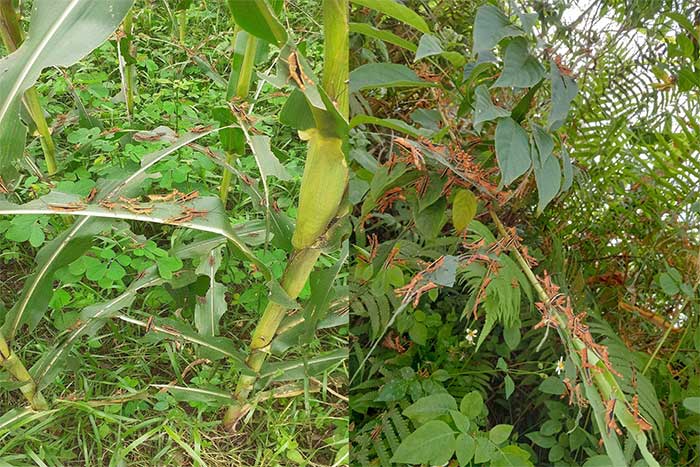To proactively prevent and minimize the damage caused by bamboo locusts in the near future, the Ministry of Agriculture and Rural Development has requested provincial People’s Committees and agencies under the Ministry to implement preventive measures…
The golden-back bamboo locust and several other species of bamboo-damaging locusts (collectively known as bamboo locusts) belong to the group of swarming locusts. When mature, they can gather in large swarms and migrate in search of food and breeding grounds.
In recent years, the golden-back bamboo locust has emerged and caused significant damage to agricultural and forestry crops in China, Laos, and Vietnam. This pest is capable of rapid movement, has a high destructive capacity, and is difficult to control.
The golden-back bamboo locust first emerged as a pest in our country in 2008, causing localized damage in mountainous districts of Quang Ngai, Nghe An, Thanh Hoa, Son La, Dien Bien, Phu Tho, Bac Kan, and Cao Bang; primarily affecting forestry plants such as bamboo, rattan, and various types of reeds.

Bamboo locusts are causing damage in 11 provinces.
From 2016 to 2018, bamboo locusts surged, damaging nearly 4,000 hectares of forestry crops and some agricultural plants (such as upland rice, corn, tobacco, bananas, and ginger); from 2019 to 2023, the emergence of bamboo locusts was on a smaller scale compared to previous years.
Since the beginning of 2024, the average temperature in the northern midland and mountainous areas has been 1-2 degrees Celsius higher than the long-term average, with many days of light rains and drizzles.
Additionally, the early and intense heat is favorable for the early emergence and damage caused by bamboo locusts starting from mid-April 2024.
As of now, bamboo locusts have emerged and caused damage in 11 out of 16 northern midland and mountainous provinces, including Cao Bang, Bac Kan, Dien Bien, Lang Son, Son La, Tuyen Quang, Hoa Binh, Phu Tho, Thanh Hoa, and Nghe An, with an infected area of 1,031 hectares.
Currently, most young bamboo locusts do not have wings, so control measures will be easier and more effective. In the next 10-20 days, the winged adults will swarm and move rapidly, posing a significant risk of severe damage to many types of crops if not detected early and controlled promptly.
Proactive Prevention to Minimize Damage
To proactively prevent and minimize damage caused by bamboo locusts in the near future, the Ministry of Agriculture and Rural Development has recommended that provincial People’s Committees and related agencies implement the following measures:
The provincial and city People’s Committees should instruct the Departments of Agriculture and Rural Development, as well as district and commune People’s Committees and specialized agencies to investigate and promptly detect locust nests in their areas and organize spraying immediately when locusts are still young; closely monitor the situation of bamboo locusts (emergence time, damage scope, movement direction, and aggregation points…) to proactively organize control measures and prevent widespread outbreaks.
Localities, especially districts and communes where bamboo locusts frequently appear, need to proactively develop plans, budgets, and prepare sufficient materials and personnel for locust control operations.
Direct local media agencies to collaborate with specialized agencies to disseminate information and guide forest owners and residents to check for the presence of bamboo locusts and to take timely and effective measures to manage them, avoiding widespread chemical spraying that could waste resources and harm the ecological environment.
Direct border guard stations in border areas to coordinate with the Departments of Agriculture and Rural Development and district People’s Committees in exchanging information about the bamboo locust situation in border regions.
Direct specialized agencies to maintain information systems and reports from localities to central authorities as required for timely coordination and direction.
Agencies and units under the Ministry of Agriculture and Rural Development, with the Plant Protection Department as the focal point, should advise, direct, and guide localities to implement technical solutions for controlling bamboo locusts.
Supervise and monitor the investigation, detection, and control of bamboo locusts in provinces and cities.
Synthesize and report to the Ministry of Agriculture and Rural Development on the emergence and development of bamboo locusts affecting crops and control direction in provinces and cities.
The Crop Production, Forestry, and Forest Protection Departments should collaborate with the Plant Protection Department and localities to inspect and monitor the investigation and control of bamboo locusts in provinces and cities; support localities in investigation, forecasting, and guiding the control of bamboo locusts.
The Vietnam Agricultural Science Institute should direct its member institutes to cooperate with the Plant Protection Department to study biological characteristics and propose effective and safe technical measures to control bamboo locusts.
The Ministry of Agriculture and Rural Development requests provincial and city People’s Committees and heads of relevant agencies and units under the Ministry to urgently direct the implementation of the above content; regularly report on the implementation status and any difficulties to the Ministry of Agriculture and Rural Development (via the Plant Protection Department) for timely resolution.



















































